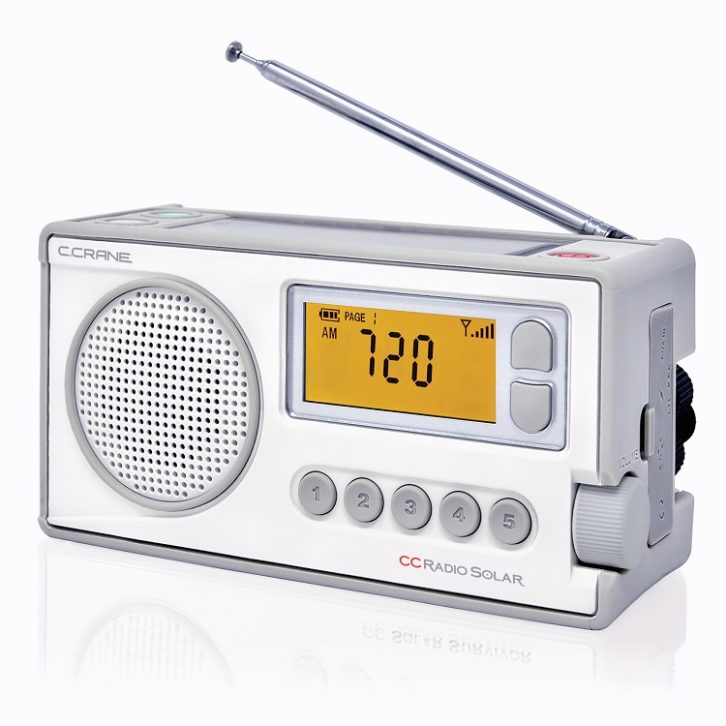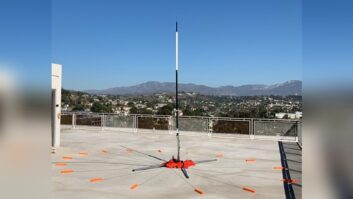 Solar-powered portable radios that put audio quality second are nothing new. But a solar-powered portable radio that sounds as good as a non-solar high-fidelity radio: This is worth talking about.
Solar-powered portable radios that put audio quality second are nothing new. But a solar-powered portable radio that sounds as good as a non-solar high-fidelity radio: This is worth talking about.
The new CCRadio Solar from C.Crane fits this double-barreled description. With its generous top-mounted solar panel (3.75 by 1.5 inches) plus back-mounted generator crank for recharging its Lithium-Ion battery pack, this is a radio for blackouts and other emergency situations.
After an initial conditioning charge-up of the Lithium-Ion battery from a 5V DC adaptor, just leave it in a sunny window, and the radio is always ready to go.
In non-emergency situations, the CCRadio Solar can be powered with three AA batteries or a 5V DC charger plugged into its micro-USB port.
Worth noting
The CCRadio Solar has an LED flashlight with glow-in-the-dark “On” switch; and its USB 3.0 port can be used to charge a connected dead smartphone to 50 percent power.
It is a fine radio for listening to AM, FM (regular or extended band) or NOAA Weather Radio.
The frequency range emitted by the front-mounted 3 watt 2-inch front speaker can be “pumped up” by activating the set’s High Power Audio Mode. The audio quality from the stereo headset jack is superb.
Perhaps the best feature for radio geeks (and non-radio geeks who live with them) is that the 6-by-3-by-2-inch CCRadio Solar with its “shades of pale grey” case looks like a tastefully designed set-top radio, rather than a piece of survivalist gear aimed at wannabe Navy SEALs.
Dual-purpose
The Solar is the brainchild of longtime radio aficionado and equipment innovator Bob Crane, owner of the C.Crane electronics store in Fortuna, Calif..
When he moved to this small remote town some 30 years ago, Crane had a difficult time tuning in the big-city AM talk stations he loved. So Bob Crane began to design and sell high-performance receivers at reasonable prices.
Today the online store sells a range of radios to fulfill a number of listening preferences, from tuning in distant AM/FM stations (e.g. the CCRadio 3 and CC Radio EP) to providing reliable multi-band coverage during extended power outages (the wind-up CCRadio Observer).
The CCRadio Solar is a departure in that it combines multiple main functions: high-fidelity audio and distant station reception with indefinite power.
Crane said you can expect 35 hours of run time between charges.
“If you are a lucky radio listener with a sunny window it is conceivable you might pay off the price of the radio with what you save on batteries.”
At $99.99 a unit, and given that I have yet to see a CCrane radio fail despite years of service, payback is a matter of time.
The nitty-gritty
Moving from left to right, the Solar’s front panel features the 2-inch speaker and a large LCD display for tuning, band information, power level and clock functions including alarm and sleep modes.
Underneath the display are five memory buttons to save presets on the AM, FM and weather bands (seven NOAA frequency channels). The memory buttons can also be used in various combinations to turn the High Power Audio mode on and off, set clock and alarm and disable the Beep sound during tuning.
For distant AM radio fans, the buttons can be used to select 1, 9 or 10 kHz tuning steps plus a narrowband 2.5 kHz filter to reject interference from strong adjacent signals. This allows the user to tune in a weak distant station adjacent to a local AM powerhouse. (The default AM wideband filter is set to 4 kHz).
Finally, the volume dial is side-mounted on the lower right side.
On the top of the radio is the solar panel, the Flashlight and Band selection buttons on the far left, and the red Power button on the right. There is a fully rotating whip antenna that folds into the side and extends from 4.5 to 25 inches for enhanced FM/Weather Radio reception.
The AM antenna is inside the set. It is directional, which means that distant signal reception can be improved by rotating the radio 90 degrees horizontally in either direction.
The radio’s settings can be locked/unlocked while in Playback mode by pressing the Band and Power buttons simultaneously.
According to the manual, eight hours of direct sunlight can provide 10 to 14 hours of audio playback at a Medium sound level (without the High Power Audio mode being activated, because its enhanced bass consumes more electricity). Hand-cranking the onboard generator for 90 seconds, at two rotations per second or more, will provide 8 to 13 minutes of runtime from the Lithium-Ion battery, assuming that it was discharged.
This winter, Crane said that with the oversize solar panel he was able to keep it fully charged using it about one hour a day at full audio power.
“It would last much longer if I switched to low-power audio. It should run four hours a day in the summer on high power.”
The flashlight and recessed mount for the included carrying strap are on the left side. On the right panel, a water-repelling rubber door protects a mini-plug Aux In jack that allows the Solar to serve as an outboard speaker; a micro-USB port for charging the unit from a 5V DC adaptor; a switch for using either the onboard Lithium-Ion battery or inserted AA batteries; a USB 3.0 port for recharging a phone; and a standard earphone mini-jack.
The rear contains the foldaway crank and the battery compartment, which houses the included rechargeable Lithium-Ion battery and three AA cells. (These can be alkaline or Ni-Cads, but not Lithium.) The inside of the compartment door contains a “Cheat Sheet” covering the radio’s basic functions.
Pros and cons
The audio quality is top-notch on all bands, even given AM’s fidelity. So is signal reception: At night when distant signals bounce off the ionosphere, the radio’s AM band is chock-a-block with stations. Tuning using 10 kHz steps was like changing the channel on a TV set; almost every frequency has something on it, though granted, signal quality varied widely thanks to the vagaries of AM propagation.
Still, the distance-listening performance is impressive. From a second-story in Ottawa, Canada, I can receive WSB 750 in Atlanta, WWVA 1170 in Wheeling W.Va./St. Clair Ohio, and KDKA 1020 Pittsburgh, among many others.
FM signals are plentiful if not as distant, and the one Canadian “Weatherradio” station available to an Ottawa listener at 162.550 MHz comes in loud and clear.
One format the radio does not offer is HD Radio. “Power consumption is probably about double on HD Radio because of the power needed to process the digital signal,” Crane said. “We will probably need to put this technology into a plug-in radio.”
As for holding a charge? After three months I have yet to manually recharge it after the initial AC charge to prime the Lithium-Ion battery. I do not keep AAs in it; the power is coming from the sun.
Since, by convention, every review is required to include a complaint to prove its journalistic integrity, I will offer one: The rubber door covering the inputs on the right side doesn’t have a hinge. One day the folding rubber crease will likely wear out, and I will be required to put some tape on it.
I have nothing but respect for the CCRadio Solar radio. Based on my 18 years of reviewing his receivers, I know that Bob Crane delivers what he promises in his custom-designed equipment. That said, the CCRadio Solar keeps its promises.









